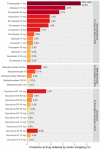Early Detection of Prescription Drug Abuse Using Doctor Shopping Monitoring From Claims Databases: Illustration From the Experience of the French Addictovigilance Network
- PMID: 34079478
- PMCID: PMC8165176
- DOI: 10.3389/fpsyt.2021.640120
Early Detection of Prescription Drug Abuse Using Doctor Shopping Monitoring From Claims Databases: Illustration From the Experience of the French Addictovigilance Network
Abstract
Opioid analgesics and maintenance treatments, benzodiazepines and z-drugs, and other sedatives and stimulants are increasingly being abused to induce psychoactive effects or alter the effects of other drugs, eventually leading to dependence. Awareness of prescription drug abuse has been increasing in the last two decades, and organizations such as the International Narcotics Control Board has predicted that, worldwide, prescription drug abuse may exceed the use of illicit drugs. Assessment of prescription drug abuse tackles an issue that is hidden by nature, which therefore requires a specific monitoring. The current best practice is to use multiple detection systems to assess prescription drug abuse by various populations in a timely, sensitive, and specific manner. In the early 2000's, we designed a method to detect and quantify doctor shopping for prescription drugs from the French National Health Data System, which is one of the world's largest claims database, and a first-class data source for pharmacoepidemiological studies. Doctor shopping is a well-known behavior that involves overlapping prescriptions from multiple prescribers for the same drug, to obtain higher doses than those prescribed by each prescriber on an individual basis. In addition, doctor shopping may play an important role in supplying the black market. The paper aims to review how doctor shopping monitoring can improve the early detection of prescription drug abuse within a multidimensional monitoring. The paper provides an in-depth overview of two decades of development and validation of the method as a complementary component of the multidimensional monitoring conducted by the French Addictovigilance Network. The process accounted for the relevant determinants of prescription drug abuse, such as pharmacological data (e.g., formulations and doses), chronological and geographical data (e.g., impact of measures and comparison between regions), and epidemiological and outcome data (e.g., profiles of patients and trajectories of care) for several pharmacological classes (e.g., opioids, benzodiazepines, antidepressants, and methylphenidate).
Keywords: addictovigilance; benzodiazepines; claims database; doctor shopping; methylphenidate; opioids; prescription drug abuse; signals detection.
Copyright © 2021 Soeiro, Lacroix, Pradel, Lapeyre-Mestre and Micallef.
Conflict of interest statement
The authors declare that the research was conducted in the absence of any commercial or financial relationships that could be construed as a potential conflict of interest.
Figures




Similar articles
-
Systematic assessment of non-medical use of prescription drugs using doctor-shopping indicators: A nation-wide, repeated cross-sectional study.Addiction. 2023 Oct;118(10):1984-1993. doi: 10.1111/add.16261. Epub 2023 Jun 12. Addiction. 2023. PMID: 37203878
-
Doctor shopping of opioid analgesics relative to benzodiazepines: A pharmacoepidemiological study among 11.7 million inhabitants in the French countries.Drug Alcohol Depend. 2018 Jun 1;187:88-94. doi: 10.1016/j.drugalcdep.2018.01.036. Epub 2018 Apr 4. Drug Alcohol Depend. 2018. PMID: 29649695
-
Doctor shopping for methylphenidate as a proxy for misuse and potential abuse in the 67 million inhabitants in France.Fundam Clin Pharmacol. 2021 Aug;35(4):751-761. doi: 10.1111/fcp.12612. Epub 2020 Dec 4. Fundam Clin Pharmacol. 2021. PMID: 33025606
-
Inputs of pharmacoepidemiology in addictovigilance: How do they fit together?Therapie. 2025 Mar-Apr;80(2):205-211. doi: 10.1016/j.therap.2024.10.058. Epub 2024 Oct 23. Therapie. 2025. PMID: 39516090 Review.
-
Defining "Doctor Shopping" with Dispensing Data: A Scoping Review.Pain Med. 2022 Jul 1;23(7):1323-1332. doi: 10.1093/pm/pnab344. Pain Med. 2022. PMID: 34931686
Cited by
-
Prévention des risques liés à un usage inapproprié/consommation inutile des médicaments.Therapie. 2022 Jan-Feb;77(1):69-78. doi: 10.1016/j.therap.2021.12.020. Epub 2022 Jan 4. Therapie. 2022. PMID: 35067334 Free PMC article. French.
-
Irrational Use of Medications among Adults with Insomnia: An Observational Study at a Sleep Clinic in Mexico.Pharmacy (Basel). 2024 Mar 27;12(2):56. doi: 10.3390/pharmacy12020056. Pharmacy (Basel). 2024. PMID: 38668082 Free PMC article.
-
Increase of high-risk tramadol use and harmful consequences in France from 2013 to 2018: Evidence from the triangulation of addictovigilance data.Br J Clin Pharmacol. 2022 Aug;88(8):3789-3802. doi: 10.1111/bcp.15323. Epub 2022 Apr 5. Br J Clin Pharmacol. 2022. PMID: 35318713 Free PMC article.
-
Understanding the diagnoses and medical care experience of patients with new daily persistent headache: a qualitative study in Spain.BMJ Open. 2021 Aug 17;11(8):e048552. doi: 10.1136/bmjopen-2020-048552. BMJ Open. 2021. PMID: 34404708 Free PMC article.
References
-
- Griffiths P, Mounteney J, Lopez D, Zobel F, Götz W. Addiction research centres and the nurturing of creativity. Monitoring the European drug situation: the ongoing challenge for the European monitoring centre for drugs and drug addiction (EMCDDA. Addiction. (2012) 107:254–8. 10.1111/j.1360-0443.2011.03369.x - DOI - PubMed
Publication types
LinkOut - more resources
Full Text Sources

